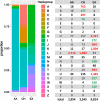MitoH3: Mitochondrial Haplogroup and Homoplasmic/Heteroplasmic Variant Calling Pipeline for Alzheimer's Disease Sequencing Project
- PMID: 38746629
- PMCID: PMC11091720
- DOI: 10.3233/ADR-230120
MitoH3: Mitochondrial Haplogroup and Homoplasmic/Heteroplasmic Variant Calling Pipeline for Alzheimer's Disease Sequencing Project
Abstract
Background: Mitochondrial DNA (mtDNA) is a double-stranded circular DNA and has multiple copies in each cell. Excess heteroplasmy, the coexistence of distinct variants in copies of mtDNA within a cell, may lead to mitochondrial impairments. Accurate determination of heteroplasmy in whole-genome sequencing (WGS) data has posed a significant challenge because mitochondria carrying heteroplasmic variants cannot be distinguished during library preparation. Moreover, sequencing errors, contamination, and nuclear mtDNA segments can reduce the accuracy of heteroplasmic variant calling.
Objective: To efficiently and accurately call mtDNA homoplasmic and heteroplasmic variants from the large-scale WGS data generated from the Alzheimer's Disease Sequencing Project (ADSP), and test their association with Alzheimer's disease (AD).
Methods: In this study, we present MitoH3-a comprehensive computational pipeline for calling mtDNA homoplasmic and heteroplasmic variants and inferring haplogroups in the ADSP WGS data. We first applied MitoH3 to 45 technical replicates from 6 subjects to define a threshold for detecting heteroplasmic variants. Then using the threshold of 5% ≤variant allele fraction≤95%, we further applied MitoH3 to call heteroplasmic variants from a total of 16,113 DNA samples with 6,742 samples from cognitively normal controls and 6,183 from AD cases.
Results: This pipeline is available through the Singularity container engine. For 4,311 heteroplasmic variants identified from 16,113 samples, no significant variant count difference was observed between AD cases and controls.
Conclusions: Our streamlined pipeline, MitoH3, enables computationally efficient and accurate analysis of a large number of samples.
Keywords: Alzheimer’s disease; haplogroup; homoplasmic and heteroplasmic variant calling; mitochondrial DNA; whole genome sequencing.
© 2024 – The authors. Published by IOS Press.
Conflict of interest statement
The authors have no conflict of interest to report.
Figures





Similar articles
-
The interplay between mitochondrial DNA genotypes, female infertility, ovarian response, and mutagenesis in oocytes.Hum Reprod Open. 2024 Dec 30;2025(1):hoae074. doi: 10.1093/hropen/hoae074. eCollection 2025. Hum Reprod Open. 2024. PMID: 39830711 Free PMC article.
-
Can a Liquid Biopsy Detect Circulating Tumor DNA With Low-passage Whole-genome Sequencing in Patients With a Sarcoma? A Pilot Evaluation.Clin Orthop Relat Res. 2025 Jan 1;483(1):39-48. doi: 10.1097/CORR.0000000000003161. Epub 2024 Jun 21. Clin Orthop Relat Res. 2025. PMID: 38905450
-
Mitochondrial DNA variant detection in over 6,500 rare disease families by the systematic analysis of exome and genome sequencing data resolves undiagnosed cases.HGG Adv. 2025 Jul 10;6(3):100441. doi: 10.1016/j.xhgg.2025.100441. Epub 2025 Apr 15. HGG Adv. 2025. PMID: 40241304 Free PMC article.
-
The effect of sample site and collection procedure on identification of SARS-CoV-2 infection.Cochrane Database Syst Rev. 2024 Dec 16;12(12):CD014780. doi: 10.1002/14651858.CD014780. Cochrane Database Syst Rev. 2024. PMID: 39679851 Free PMC article.
-
Regional cerebral blood flow single photon emission computed tomography for detection of Frontotemporal dementia in people with suspected dementia.Cochrane Database Syst Rev. 2015 Jun 23;2015(6):CD010896. doi: 10.1002/14651858.CD010896.pub2. Cochrane Database Syst Rev. 2015. PMID: 26102272 Free PMC article.
Cited by
-
Alzheimer's Disease Sequencing Project Release 4 Whole Genome Sequencing Dataset.medRxiv [Preprint]. 2024 Dec 6:2024.12.03.24317000. doi: 10.1101/2024.12.03.24317000. medRxiv. 2024. Update in: Alzheimers Dement. 2025 May;21(5):e70237. doi: 10.1002/alz.70237. PMID: 39677464 Free PMC article. Updated. Preprint.
-
Alzheimer's Disease Sequencing Project release 4 whole genome sequencing dataset.Alzheimers Dement. 2025 May;21(5):e70237. doi: 10.1002/alz.70237. Alzheimers Dement. 2025. PMID: 40407102 Free PMC article.
References
-
- Stewart JB, Chinnery PF (2015) The dynamics of mitochondrial DNA heteroplasmy: Implications for human health and disease. Nat Rev Genet 16, 530–542. - PubMed
Grants and funding
LinkOut - more resources
Full Text Sources
Miscellaneous

